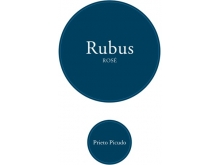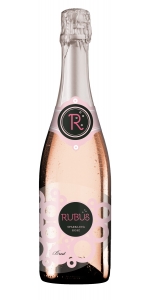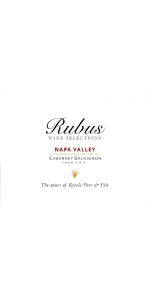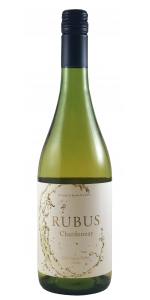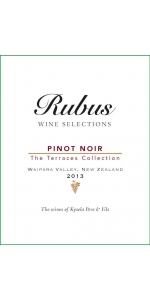Rubus Rosado Prieto Picudo 2013
| Country: | Spain |
| Regions: | Leon Tierra de Leon |
| Winery: | Rubus |
| Grape Type: | Prieto Picudo |
| Vintage: | 2013 |
| Bottle Size: | 750 ml |
Rubus Brut Blanc de Blanc NV is made from 1/3 Ugni Blanc, 1/3 Airen, 1/3 Muscat .
The Rubus Project was created by Fran Kysela as a way to source & sell incredible wines at value prices. All wines in this international project are hand-selected by Fran Kysela. Rubus wines are fruit driven, true-to-type values that over deliver - a true representation of quality for the consumer at an excellent price.
Elegant pale yellow color with fine bubbles. Floral and fruity on the nose, with aromas of fresh butter and cake. On the palate, the wine is crisp and harmonious - a delightful sparkling wine.
Machine harvest. The base wine is fermented at a low temperature. The second fermentation takes place at 14°C for 2 weeks, followed by dosing.
Rubus Brut Rose is made from 60% Tempranillo, 40% Bobal.
The Rubus Project was created by Fran Kysela as a way to source & sell incredible wines at value prices. All wines in this international project are hand-selected by Fran Kysela. Rubus wines are fruit driven, true-to-type values that over deliver - a true representation of quality for the consumer at an excellent price.
Stunning salmon-pink hues. The nose is intense and fine, dominated by notes of red berries. On the palate, the combination of fine bubbles and delicate aromas produces a delightfully light and silky rosé.
Machine harvest. The base wine is fermented at a low temperature. The second fermentation takes place at 14°C for 2 weeks, followed by dosing.
Rubus Cabernet Sauvignon Napa Valley is made from 100 percent Napa Valley Cabernet
Its long finish displays full mature flavors of blackberry, currant and chocolate with just a hint of toasty oak and black cherry. The tannins are refined and polished, allowing the fruit to be the focus.
Rubus Chardonnay Colchagua Valley is made from 100 percent Chardonnay.
Attractive yellow color with some green tones. Its intense varietal character reminds one ripe fruits like pineapple, with notes of melon and honey well harmonized with oak. In the mouth it is full, rich and buttery.
Grapes are harvested in the morning in order to avoid high temperatures.
At the winery, the grapes are gently pressed.
Alcoholic fermentation is held between 15º and 16º Celsius.
Then, 25% of the wine goes into American Oak barrels for 3 months.
After this, the blend is made, clarified, cold stabilized and filtered. Right before bottling, the wine goes through an on-line filtration system (plate and sterile membrane) to ensure microbiological stability
As far as the food pairing, it is delicious with pasta, fish, seafood and mild cheeses. It is also delicious on its own as an aperitif.
SALE!
Lodi, American Viticulture Area (AVA) – The Lodi AVA is located in the northern end of the San Joaquin Valley, Central Valley California, east of the San Francisco Bay. Lodi has warm days and cool nights, similar to the Mediterranean climate. The lower temperatures that occur in Lodi result in fruit with good acidity. A wide range of soils are found in the Lodi AVA, but they generally are deep, loamy, sandy, rocky soils similar to that found in southern Rhone valley.
The Lodi appellation totals almost one half million acres, and the approximately eight hundred growers farm roughly 90,000 acres. Lodi produces more Cabernet Sauvignon, Chardonnay, Merlot, Sauvignon Blanc, and Zinfandel than any other wine region in California, but it is probably best known for its old vine Zinfandel. The vines are often head trained giving them a classic old world appearance.
Zinfandel – The Zinfandel grape is a hearty variety that produces grapes with high sugar levels, often resulting in wines with a high alcohol content. Thought to be a relative of Primitivo that is found in southeast of Italy (the boot heel), Zinfandel can be made into a wide range of wine styles, including White Zinfandel, light or full bodied red wines, and even late harvest desert style wine. However Zinfandel, especially Old Vine Zinfandel from Lodi, is usually made into a full bodied, spicy red wine with characteristics of red fruit, raspberry, and cherry.
Produced in the heart of Lodi AVA.
Rubus Zinfandel Lodi is made from 98% Zinfandel + 2% Cabernet Sauvignon
Bottled after aging in French and American oak for 9 months.
Rubus Zinfandel Lodi presents with ruby red in color, with red fruit, raspberry, and spice on the nose. This wine is medium in body, with notes of ripe cherry, cedar box, cinnamon, anise, black pepper, and hint of smoke on the palate. It has a long, silky finish.
Selected by Fran Kysela MS.
The Rubus Project was created by Fran Kysela as a way to source & sell incredible wines at value prices. All wines in this international project are hand-selected by Fran Kysela. Rubus wines are fruit driven, true-to-type values that over deliver - a true representation of quality for the consumer at an excellent price.
Grapes are sourced from the Lessini hills in the Colli Berici, where the cold nights allow the aromatic compounds in the grapes to develop. The vines, 20 years old on average, are planted on calcareous soils of volcanic origin.
Nice garnet and red color. Expressive and charming on the nose with cherry and blackberry aromas. On the palate, the wine has a nice spicy note. The length to the finish is round and long.
Rubus Pinot Noir is made from 100 percent Pinot Noir from Veneto Italy
Tasting notes: Nice garnet and red color. Expressive and charming on the nose with cherry and blackberry aromas. On the palate, the wine has a nice spicy note. The length to the finish is round and long.
Vineyards:
The grapes are grown primarily on the hills south of Vicenza, the Colli Berici, where the hillside sites ensure lower yields and better ripeness of the grapes.
The vineyards are located in the hills and are south-west facing. The hillside sites experience cooler nights, allowing the aromatic compounds in the grapes to develop. The vines are trained using the Guyot system, planted on calcareous soils of volcanic origin.
Average age of the vines is around 20 years old.
Vinification:
The grapes were harvested, destemmed, crushed and then cool soaked for 24 hours. Maceration on the skins took place before fermentation at temperatures of up to 22°C. Following malolactic fermentation, 30% of the wine was aged in oak for four to five months prior to bottling.
Winemaker: Alberto Marchisio
Acidity: 5.3 g/Liter
RS: 5.6 g/Liter
pH: 3.42
Nice with roasted or grilled beef, game and a very good companion for matured cheese.
Rubus Rosado Prieto Picudo 2013 is made from 100% Prieto Picudo.
Prieto Picudo is a red grape varietal grown in the interior of northwestern Spain, mainly the provinces of León and Zamora. It is the principal red grape variety in the D.O. Vino de la Tierra de León. Reds from this D.O. are required to be 60% or more Prieto Picudo. Whites are also produced with Albarín Blanco, Verdejo & Godello.
The name means "tight & pointy" (more or less). This is due to the tightly formed bunches and the slightly oval/pointy shape of the grapes. The bunch shape is reminiscent of Tempranillo; the berries are thick skinned, and dark blue-black in color. Prieto Picudo is well adapted to the difficult growing conditions in Castilla y León province - not a lot of rain, very cold winters and scorching hot summers.
The vines tend to relatively low yields, with lots of color, concentration and good acidity. Careful work in the vineyard is important, to avoid wines being harsh & overly tannic. The wines tend to age well, with firm tannins & good acidity.
A traditional style, slightly spritzy wine ("Aguja") is made in the area with Prieto Picudo and a method called "madreo". A second fermentation is provoked by adding additional bunches of grapes (stems & all) to the fermenting wine, giving it a touch of CO2 spritz and a distinctive taste.
Also, it's the same grape as Alfrocheiro Preto in Portugal. Alfrocheiro is an important variety in Dão region of Portugal.
Tasting note:
Bright clean strawberry rose color. In the nose it is intense and fresh, with strawberry aromas and slight citric hints. In the mouth it is fresh, strong and tasty, emphasizing a delightful tingle due to its carbonic residuals. 
Alcohol: 13.6% Vol.
Total acidity: 5.4 g/l
Volatile acidity: 0.35 g/l of acetic acid
pH: 3.40
Residual Sugar: 2.6 g/l
Ideal serving temperature: 8– 10º C
Food Pairing: Perfect results when combined with salads, rice and fish. Also with roast chicken and cold appetizers.
The Rubus Concept
Rubus wines are a private label created and used by Kysela Pere et Fils, LTD in order to buy, bottle and market wine found at incredible quality/price ratio. All Rubus wines are selected by Fran Kysela MS.
It was first used for a superb batch of 1,200 cases of Amador county Zinfandel back in 1997. The wine sold in a few days and the Rubus brand was not used since then.
During a trip in California in 2009, when Fran Kysela tasted some incredible wines (available in bottle but without label), he decided to help resurrect the brand creating an outstanding Cabernet Sauvignon from Stag's Leaps district in Napa Valley (California) , followed by an excellent Chardonnay from Russian River Valley (California)
We then developed the Rubus Zinfandel from Lodi (California).
In 2011, we added a Shiraz/Viognier blend from the Barossa in Australia.
For 2012, the newest addition to the Rubus line is a Chardonnay from Colchagua Valley in Chile.
Rubus is now its own brand representing quality for the consumer and an incredible price along the way.
Rubus Meaning
The name RUBUS means "raspberry" in Latin and it is the name given to the genus of flowering plants in the rose family. For instance, here are some famous fruit from the Rubus family with their latin names:
Rubus fruticosus agg. – Blackberry
Rubus idaeus – European Red Raspberry
Rubus occidentalis – Black Raspberry
Rubus pensilvanicus – Pennsylvania Blackberry
Rubus strigosus – American Red Raspberry
- back
Dominique Piron Morgon Cote du Py is made from 100 percent Gamay.
The Morgon Cru is based in the heart of Northern Beaujolais. Côte du Py is the heart of Morgon, a little hill of very old blue stone rocks - the oldest soils of Beaujolais (around 430 millions years old), with a typical blue color.
Côte du Py has been known for centuries for being the best terroir of the village, producing long lived wines with strong structure and flavors.
Wines of the Côte du Py are very dark, profound and dense. Classic aromas of red berries, cherry, kirsh. Fruity, structured and mineral in the mouth with graphite flavors and spicy notes of black and white pepper. Wine can age up to 10 years.
Hand picked grapes are sorted manually and destemmed for 50 to 70%. Fermentation starts in concrete tanks and lasts for 18-25 days with remontages and pigeages. Then after pressurage starts the aging, for 2/3 in concrete tanks, and 1/3 in recent French oak barrels with batonages on fine lies only. After 10 month we do the blending, keeping only the best cuvees and best barrels, and do the bottling.
Pairs well with red meat like beef, duck and game (Hare, Dear, Wild Pork,…), cheses.
The Prisoner Wine Co. Blindfold Chardonnay is made from 100 percent Chardonnay.
Blindfold Chardonnay is gorgeously balanced and a true triumph. Fragrant with notes of lime zest, yuzu, jasmine, and a slight minerality, Bright on the palate with juicy green citrus, lychee, green apple and toasted hazelnut. You’ll find both freshness and soft texture from its time in oak. The finish is long and indulgent–let yourself sink into this luxurious pour.
All of the fruit was hand-picked and whole cluster pressed. Barrel fermentation took place in 100% French oak barrels, and 23% New barrels that were selected by forest or grain tightness to frame our fruit profile, bring texture, and soften acidity. Lots were tasted every other week while we stirred the lees to precisely soften the mouthfeel and achieve optimal balance. With fermentation, and subsequent elevage taking place over 11 months we have achieved this goal.
Chardonnay grapes were harvested as flavors of lime zest and green apple started to develop and before acid started to ripen away. Picking decisions were made based on acidity rather than sugar level (Brix). We want to showcase the vineyard sites and growing region in perfect balance.

